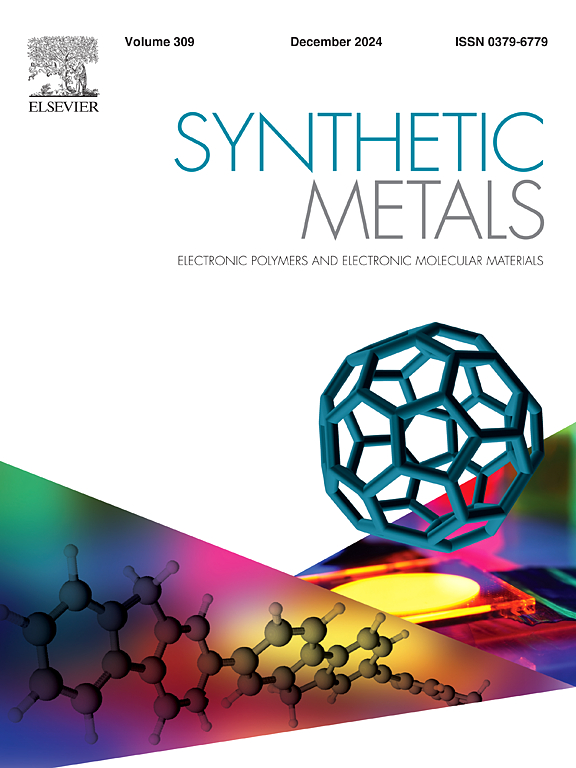用12,12-二甲基-7-苯基-7,12-二氢苯并[a]吖啶-3-碳腈(BACN)掺杂设计新的第一代和第五代OLED发射体:DFT研究
IF 4.6
3区 材料科学
Q2 MATERIALS SCIENCE, MULTIDISCIPLINARY
引用次数: 0
摘要
本文采用DFT和TD-DFT研究了钾掺杂对BACN的电子、NLO和光物理性质的影响。结果表明,掺杂1个(M1样品)或2个(M2样品)钾原子可以提高纯BACN (M0样品)的电子和光学性能,使带隙从M0的3.70 eV减小到M1的2.97 eV和M2的2.34 eV。这种还原增加了电子导电性和分子内电荷转移。与M0相比,掺杂化合物的一阶超极化率值为M1的8倍,M2的9倍,这表明与未掺杂化合物M0相比,掺杂化合物是非线性光学应用的优秀候选者。在光物理性质方面,M1在S1和T1之间表现为倒置的单重态-三重态(IST),其特征为∆EST=−0.66eV,具有低RISC过程。M1的紫外-可见光谱显示出双激发,最大波段在近紫外范围内,而其发射光谱在415.44 nm处出现峰值,CIE色坐标为(0.20,0.18),表明M1是第五代蓝色oled的理想候选材料。而M2的吸收光谱和发射光谱在可见光谱处分别在413.22 nm和400.61 nm处达到最大值。因此,M2可以用作第一代oled的发射器,用作抗菌光源,也可以用作有机太阳能电池(OSCs)的吸收剂。本文章由计算机程序翻译,如有差异,请以英文原文为准。
Design of new first and fifth generation OLED emitters by doping 12,12-dimethyl-7-phenyl-7,12-dihydrobenzo[a]acridine-3-carbonitrile (BACN): DFT study
In this paper, DFT and TD-DFT were used to investigate the impact of potassium doping on the electronic, NLO, and photophysical properties of BACN. The results indicate that doping with one (sample M1) or two (sample M2) potassium atoms enhances the electronic and optical properties of pure BACN (sample M0), reducing the bandgap from 3.70 eV for M0 to 2.97 eV for M1 and 2.34 eV for M2. This reduction increases electronic conductivity and intramolecular charge transfer. The first order hyperpolarizability values of the doped compounds are approximately 8 times higher for M1 and 9 times higher for M2 compared to M0, suggesting that the doped compounds are excellent candidates for nonlinear optical applications compared to the undoped compound M0. Regarding photophysical properties, M1 exhibits an inverted singlet-triplet (IST) state characterized by between S1 and T1, with a low RISC process. The UV-Vis spectrum of M1 reveals a double excitation with maximum bands in the near UV range, while its emission spectrum shows a peak at 415.44 nm with a CIE chromatic coordinate of (0.20, 0.18), indicating that M1 is a promising candidate for fifth-generation blues OLEDs. In contrast, the absorption and emission spectra of M2 show maxima in the visible spectrum at 413.22 nm and 400.61 nm, respectively. Thus, M2 can be used as an emitter for first-generation OLEDs used as antibacterial light sources, as well as an absorber for organic solar cells (OSCs).
求助全文
通过发布文献求助,成功后即可免费获取论文全文。
去求助
来源期刊

Synthetic Metals
工程技术-材料科学:综合
CiteScore
8.30
自引率
4.50%
发文量
189
审稿时长
33 days
期刊介绍:
This journal is an international medium for the rapid publication of original research papers, short communications and subject reviews dealing with research on and applications of electronic polymers and electronic molecular materials including novel carbon architectures. These functional materials have the properties of metals, semiconductors or magnets and are distinguishable from elemental and alloy/binary metals, semiconductors and magnets.
 求助内容:
求助内容: 应助结果提醒方式:
应助结果提醒方式:


